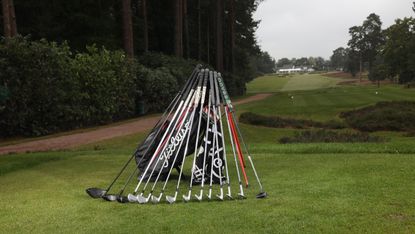Should My Golf Clubs Have Regular Or Stiff Shafts?
A crucial choice when buying golf clubs is what shaft flex to select. Here we give you the information you need to decide between regular and stiff shafts


Around 80% of golfers are suited to either regular or stiff shafts and getting the flex right to suit your swing is one of the most important choices you have to make when buying new clubs.
If you choose a shaft that is overly flexible, and too light, you'll have too much power for the club. You'll miss shots high and left and the club will be out of control through the swing.
What Happens If A Golf Shaft Is Too Stiff?
Opting for a shaft that is too stiff and heavy for your game will make you swing more slowly and miss more shots low and right - that's because you'll struggle to bring the face back square at impact.
To make the right decision when it comes to swing flex, you have to make an honest appraisal of your game. What is your bad miss? What is the weakness of your game and could the flex of your shafts be to blame?

When it comes to deciding what shaft you need, it's important to consider your swing speed.
What's the difference between regular and stiff shafts?
A stiff shaft is firmer and harder to bend than a regular shaft. Generally, they also weigh more than a regular shaft.
As a rough guide, the more speed you generate through your swing, the stiffer your shafts need to be. That is not to say that only players with a quick tempo should use stiff shafts. Players who swing slowly but accelerate hard through the ball can generate significant lag and power and will benefit from using stiffer shafts in their clubs.
The distance you hit the ball gives a good indication of what shafts you should be using. Those who naturally hit the ball a long way tend to benefit from having stiffer shafts in their clubs. Shorter hitters will get more out of a regular shaft as these will flex more and help create speed through impact. Organise a fitting with a qualified PGA professional to get more of an understanding of your personal requirements.
Get the Golf Monthly Newsletter
Subscribe to the Golf Monthly newsletter to stay up to date with all the latest tour news, equipment news, reviews, head-to-heads and buyer’s guides from our team of experienced experts.
In the end, the objective when selecting shafts is to match your swing with the correct shaft flex, thereby maximising distance whilst maintaining optimum control. One of the often forgotten fundamentals of golf is how many rather than how. Don't be too proud to opt for a regular or lightweight shaft if that is going to deliver improved performance. What does the shaft spec of your club matter if you're hitting it further and straighter?!
What is kick point in a golf shaft?

Should you choose a shaft with a high or low kick point?
The kick point is where the shaft flexes the most. A club with a high kick point will generally produce a lower trajectory. This will help players who lose distance from a higher, spinnier flight. A low kick point in a shaft, on the other hand, will launch the ball higher.
Stiffer shafts need more power or a more efficient action to perform at an optimum level. Stiff shafts will usually have a higher kick point as they're generally used by better players who are looking to control their ball flight, rather than get the ball up in the air.
Should I Use Graphite Or Steel Shafts?
This is a question that really relates to your irons, as your woods and driver will almost certainly have graphite shafts. Generally speaking, graphite shafts are slightly lighter than steel ones and that will help those with slower swings gain distance. A lighter graphite shaft will help some golfers improve their ball flight and gain yardage. It's worth asking about graphite shafts if you go for a fitting and are looking to gain distance and forgiveness.
What happens if you use a stiff shaft with a slow swing?

Which flex is best for me?
If you use a stiff shaft with a slow swing, you will not get the most from your shots.
You need to work out which shaft will be best for your swing and your game - stiff or regular. There are a few ways you can work this out. You could test both stiff and regular shafts side-by-side on a driving range or out on the course. Take a look at the typical ball flights with each. You should notice a difference, plus feel a difference through swing and strike. Then you can decide which one is working best in terms of both distance and accuracy.
Measuring your swing speed on a launch monitor is a useful exercise. Book a session with a professional and they will be able to advise you on what shafts will help you get the most from your game.
Really, the best way to find your ideal flex is to go for a custom fitting session. In one of those, you'll be able to try various shafts with varying flexes and weights to see which delivers the best results. Launch monitor data will give you definitive evidence of which shaft is right for you.

In July 2023, Neil became just the 9th editor in Golf Monthly's 112-year history. Originally working with the best coaches in the UK to produce instruction content, he has also presented many Golf Monthly videos looking at all areas of the game from Tour player interviews to the rules of golf.
Throughout his time with the brand he has also covered equipment launches that date back well over a decade. He clearly remembers the launch of the Callaway and Nike square drivers as well as the white TaylorMade driver families, such as the RocketBallz! If you take a look at the Golf Monthly YouTube channel, you'll see his equipment videos dating back over a decade! He has also conducted 'What's In The Bag' interviews with many of the game's best players like Rory McIlroy, Dustin Johnson and Jon Rahm. Over the years, Neil has tested a vast array of products in each category and at drastically different price-points.
Neil is currently playing: Driver: TaylorMade Stealth Plus Fairway Wood: Titleist TSR2 Hybrid: Titleist TS3 Irons: PING Blueprint S (4&5), PING Blueprint T (6-PW) Wedges: Titleist Vokey SM7 50˚, 54˚, 60˚ Putter: Odyssey Triple Track Ten Ball: Titleist Pro V1X
- Fergus BissetContributing Editor
-
 Tiger Woods' Clothing Brand Announce Opening Of First Pop-Up Shop In Iconic Golf Location
Tiger Woods' Clothing Brand Announce Opening Of First Pop-Up Shop In Iconic Golf LocationAfter Sun Day Red was revealed in February 2024, Woods' clothing brand has announced its first pop-up shop opening at the iconic Pebble Beach
By Matt Cradock Published
-
 Which College Players Went Straight To LIV Golf?
Which College Players Went Straight To LIV Golf?LIV Golf has vast experience among its ranks, but a few players made the leap to the big-money circuit straight from college – here are the details
By Mike Hall Published
-
 What Do The Top 10 Drivers On The PGA Tour Use?
What Do The Top 10 Drivers On The PGA Tour Use?Sam De’Ath dives into what models are used by the best off the tee on the PGA Tour
By Sam De'Ath Published
-
 I've Tested Everything And These Are The 3 Most Underrated Golf Clubs Of 2024
I've Tested Everything And These Are The 3 Most Underrated Golf Clubs Of 2024The golf clubs played on tour by the world's best players often steal the limelight, but which alternatives do we rate highly? Here are our top three...
By Joe Ferguson Published
-
 Which Driver Has The Most PGA Tour Wins This Season?
Which Driver Has The Most PGA Tour Wins This Season?Over the course of 2024, one model leads the way in the 'drivers championship'
By Michael Weston Published
-
 What Fairway Woods Do The Top 10 Golfers In The World Use?
What Fairway Woods Do The Top 10 Golfers In The World Use?Sam De’Ath takes a look into the bags of the best fairway wood players in the world and the makes and models they use to attack greens from long range
By Sam De'Ath Published
-
 How Many Wedges Should I Carry In My Golf Bag?
How Many Wedges Should I Carry In My Golf Bag?You want your line-up of scoring clubs to give you the best opportunity to shoot low scores
By Matt Cradock Published
-
 What Is The Most Played Driver At The 2024 Presidents Cup?
What Is The Most Played Driver At The 2024 Presidents Cup?Take a look at what drivers are in play this week as the International team lock horns with the USA on a demanding golf course
By Sam De'Ath Published
-
 The 6 Most Popular Driver Models Used On The PGA Tour
The 6 Most Popular Driver Models Used On The PGA TourMost golf fans could list the top players in the world for ball striking off the tee, but what drivers do they use and which are most popular on the PGA Tour?
By Barry Plummer Published
-
 What Is The Most Played Driver At The Solheim Cup 2024?
What Is The Most Played Driver At The Solheim Cup 2024?24 of the world's best female golfers are squaring off against each other this weekend in Virginia, but what drivers are on display?
By Joe Ferguson Published